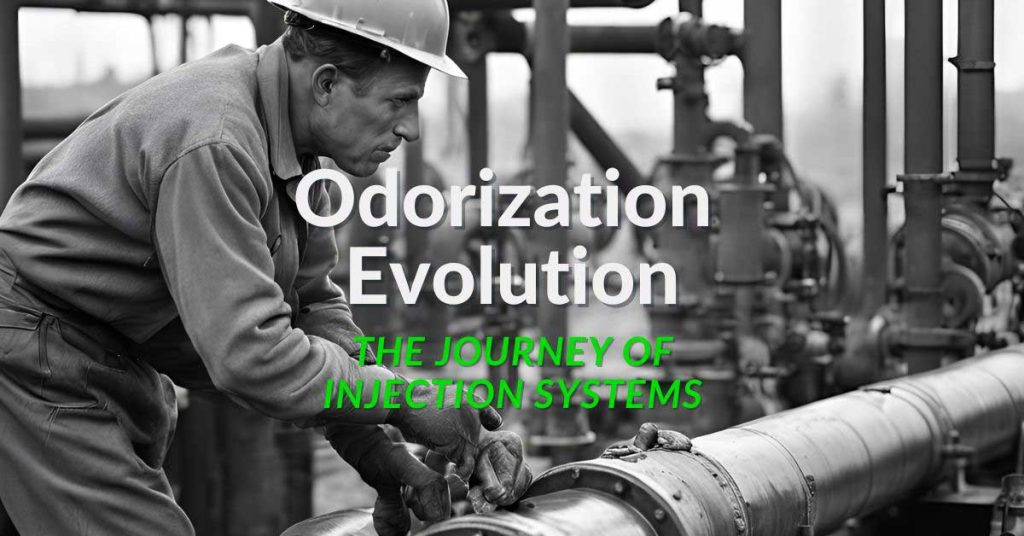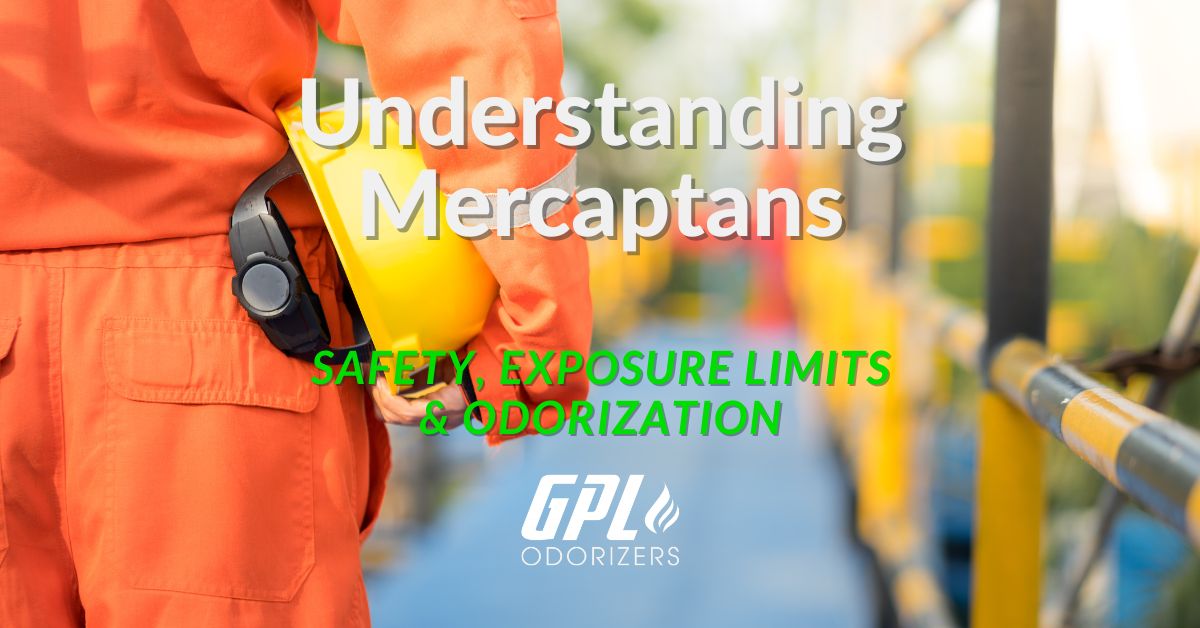Gas odorization is the process of adding a distinct, recognizable smell to naturally odorless gases like natural gas, propane, or liquefied petroleum gas (LPG). This safety measure allows for quick detection of gas leaks, potentially preventing explosions and saving lives. The history of gas odorization is a testament to human ingenuity in the face of disaster and the ongoing commitment to public safety.
 The Scentless Menace: Early Days of Gas Distribution
The Scentless Menace: Early Days of Gas Distribution
Natural gas has been used for thousands of years, with the earliest recorded use dating back to 500 BCE in China. However, its widespread commercial use began in the 19th century.
Detecting Danger: Primitive Methods of Gas Leak Detection
In these early days, gas was distributed without any added odor, relying on four methods for detecting gas:
- Visual detection: In some cases, a gas leak might be visible as a shimmering effect in the air, similar to heat waves rising from a hot surface. This type of detection was not reliable, especially for small leaks.
- Sound: Large leaks might be audible as a hissing or whistling sound. Again, it is not reliable for small leaks.
- Physical symptoms: When exposed to high concentrations of natural gas, people might experience dizziness, nausea, or headaches. However, relying on someone to get sick is certainly not prudent, as the leak had already reached hazardous levels.
- Flame test: In some cases, professionals might use a controlled flame to check for the presence of gas in an area. Flame tests are hazardous and not recommended for general use.
It would be only logical that this lack of odorization led to numerous accidents, resulting in hundreds of deaths and injuries. The inability to quickly detect gas leaks was a significant safety concern that needed addressing.
A Whiff of Change: The Birth of Gas Odorization
The turning point came on March 18, 1937, with the New London School explosion in New London, Texas. A natural gas leak in the school’s basement went undetected, leading to an explosion that killed nearly 300 students and teachers. Some sources place the death toll between 295 and 300, while others report slightly lower numbers. Regardless of the exact figure, this tragedy shocked the nation and became the catalyst for mandating gas odorization.
Texas Takes the Lead: Pioneering Odorization Regulations
In the aftermath, the Texas Legislature quickly passed a law requiring that natural gas be odorized. Other states soon followed suit, implementing their own odorization requirements through state-level regulations.
During the 1950s and 1960s, the natural gas industry largely self-regulated odorization practices. Odorization became a standard practice in the industry, guided by state regulations and industry standards. The American Gas Association (AGA) and other industry groups developed recommended practices and standards for odorization, which many companies voluntarily adopted.
The Natural Gas Pipeline Safety Act, passed in 1968, was the first federal law to address pipeline safety comprehensively, including odorization. In 1970, the Department of Transportation (DOT) issued the first federal regulations on gas pipeline safety, including specific requirements for odorization.
The Science of Smell: Evolution of Odorants
Odorants are chemicals injected into gas to cause it to smell. The first odorants used were simple sulfur compounds like ethanethiol (ethyl mercaptan). These chemicals have a strong, distinctive smell even at very low concentrations. However, they have drawbacks, such as toxicity and instability.
As research progressed, more complex odorant blends were developed. These typically included a mix of alkyl mercaptans, tetrahydrothiophene, and other sulfur compounds. Each component was chosen for specific properties:
- Mercaptans: Provide the characteristic “rotten egg” smell
- Tetrahydrothiophene: Adds a garlic-like odor
- Sulfides: Enhance overall smell intensity and persistence
Blending for Safety: Modern Odorant Formulations
Modern odorant blends are designed to be:
- Highly detectable at low concentrations
- Stable and long-lasting in gas pipelines
- Safe for human exposure at typical concentrations
- Compatible with gas appliances and equipment
Precision Perfected: Advancements in Odorization Equipment
Early odorization was done manually, with workers regularly adding liquid odorant to gas pipes. This method was imprecise, labor-intensive, and unsafe.
From Manual to Automated: The Journey of Injection Systems
The first automated systems, developed in the 1940s and 1950s, used mechanical pumps to inject odorants at a fixed rate. The development of automated odorization systems was likely a gradual process with incremental improvements by various companies and inventors rather than a single breakthrough by one company. While an improvement, these systems didn’t account for variations in gas flow and were prone to over- and under-odorization.
Modern electronic flow-proportional systems were introduced in the 1980s and continually refined since they precisely measure gas flow and adjust odorant injection accordingly. These systems ensure consistent odorization levels and can be remotely monitored and controlled.
Sniffing Out Safety: Regulatory Milestones in Gas Odorization
Following the New London School disaster, regulations requiring gas odorization quickly spread. In the United States, the Department of Transportation’s Pipeline and Hazardous Materials Safety Administration (PHMSA) now oversees federal regulations on gas odorization.
Key regulatory milestones include:
- 1937: Texas mandates gas odorization
- 1968 Natural Gas Pipeline Safety Act establishes federal safety standards
- 1990s: Introduction of more specific odorization level requirements
- Ongoing: Regular updates to reflect new technologies and safety data
Internationally, most countries have adopted similar regulations, though specific requirements may vary.
Scent of the Future: Innovations in Gas Safety
Today’s odorants are highly refined blends optimized for detectability, stability, and safety.
Common blends include:
- Mercaptans (Thiols)
- Tert-Butyl Mercaptan (TBM)
- Ethyl Mercaptan
- Propyl Mercaptan
Modern odorization equipment features:
- Precise electronic control systems
- Real-time monitoring and data logging
- Remote operation capabilities
- Fail-safe mechanisms to ensure continuous odorization
Zero Emissions, Maximum Safety: GPL Odorizers’ Breakthrough
In recent years, significant advancements have been made in odorization technology, with companies pushing the boundaries of efficiency and environmental responsibility. A notable breakthrough came from Zeck Systems, who developed the industry’s first no-emission system. GPL Odorizers acquired this technology and has improved it, maintaining accuracy even at challenging flow rates. These innovations represent a significant step forward in odorization technology, addressing environmental concerns and the need for precise odorant injection across various operating conditions.
Beyond the Nose: The Future of Leak Detection
The future of odorization technology, based on historical trends and current advancements, may include:
- Continued research into new odorant compounds that are more stable and less prone to “odor fade” (loss of smell over time in pipelines)
- Development of “intelligent” odorization systems that can adapt to changing gas compositions
- Integration with smart gas networks for improved monitoring and control
- Exploration of non-chemical methods for leak detection to complement odorization, such as acoustic sensors, optical gas imaging, laser-based detection, drone-based systems, distributed fiber optic sensing, artificial intelligence and machine learning, and biosensors
The future will likely present breakthroughs on some current challenges, such as:
- Odor masking in certain environments
- Variations in individual smell perception
- Potential odorant interactions with new pipe materials
Conclusion
The evolution of gas odorization from its origins in tragedy to today’s sophisticated systems demonstrates the critical role of safety innovation in the energy industry. As we continue to rely on natural gas and other odorless fuels, ongoing advancements in odorization technology will remain crucial for public safety.
If you want more information regarding GPL Odorizers, the pioneer of the zero-emissions odorization system designed to enhance safety and detectability, message us today.

Wow. Almost every kid in town – gone.
Of all the subjects ive haf a discussion about this one of the obscure topict that google had the answer to brovo.
Watching a documentary that claimed a gas explosion in 1887 in Boston was preceded by a smell. Could that be true?
THE DEATH OF THE FAMILY IN MEXICO WAS FROM A GAS LEAK IN THE WATER HEATER DOES MEXICO INSTALL THE SAME CHEMICAL IN THEIR NATURAL GAS AS WE DOE IN THE USA
I was wondering the same thing and cannot find an answer anywhere.
A lady just died from a gas explosion at a 5-star resort (in her villa) I go to every year in Cabo. These villas rent for between $1200-$1500 per night for last minute guests. The answer came back to me that no they don’t odorize the gas in Mexico and it is a really big problem.
My son and I were almost killed by carbon monoxide due to a leaking seal in a hot water tank in a rented house. No, we did not get a settlement and we have been trying to get our health back for the past 12 years. There is no smell to this kind of leak and it can go on for months before it completely ruptures. There is no smell because Carbon Monoxide is a by-product of a gas that is not fully burned. So the smell of natural gas has burned up but not the by-product Carbon Monoxide.
And that is why having a portable carbon monoxide detector is so important when traveling and permanent ones installed in every home.
Mexico City is one of the last large cities that doesn’t have pipes delivery of natural gas but relies on propane delivery. Propane, unlike, natural gas, is heavier than air and can pool as a gas in low areas and basements.
Stop screaming. It’s rude.
ah censorship of the web means you can ask a question and the answer isnt there , i mean all i want to know is when natural gas was first given its modern scent in the UK …no answer exists back to the library for me
Approximately 1937 for US andCanada ?
this is what I found.
From:
International Journal of Greenhouse Gas Control
Volume 37, June 2015, Pages 504-512
International Journal of Greenhouse Gas Control
Odourisation of CO2 pipelines in the UK: Historical and current impacts of smell during gas transport
2.3.2. Reformed gas
Technical advances improved the efficiency of gas manufacture. >>From the late 1950’s, various high temperature reforming processes were utilised to make gas from petroleum products such as naphtha or propane; this reformed gas (gas produced from oil) had no discernible odour associated with it (Sonley, 2012). In keeping with the regulations as outlined by the Gas Acts during that time, a method of detection was necessary. <<At the time, operations were controlled by twelve area Gas Boards, which were governed by the Gas Council. Discussions took place to add a smell, which would be suitable and meet the Gas Acts requirements. Based on the odourants used in America, thiolane (THT, (CH2)4S) a saturated analogue of thiophene was selected (Sonley, 2012). Additionally, many of the coal gas pipes were reused which retained the distinct coal gas odour. This meant the reformed gas also retained the familiar warning smell the public were accustomed to for a limited amount of time.
I believe the UK began odorizing their gas in the late 1880’s because of the street lamps .
Coal gas was dominantly used until the 1960’s, when it was replaced by other forms of natural gas. Coal gas has a naturally distinctive smell associated with it”
See: Science Direct: Odourisation of CO2 pipelines in the UK: Historical and current impacts of smell during gas transport
If you read the full article you will see Germany added odorants into their gas in the 1800’s I am sure places like England and France followed suit shortly after and then the whole of the UK was not far behind.
We are Neftegaz Energy Consultant, currently working as a direct mandate to a Russia Refinery who has following Petroleum products in Rotterdam and Russia for urgent lift on CI Dip & Pay
We have JETA1 & JP54 Up-to 2 million Barrels, D6 Up-to 800 million Gallons, D2 Up-to 150kMT on CI Dip and Pay.
If you are a direct buyer or have an interested buyer or buyer mandate, contact us via below contacts for Soft Offer.
Maksim Yaroslav